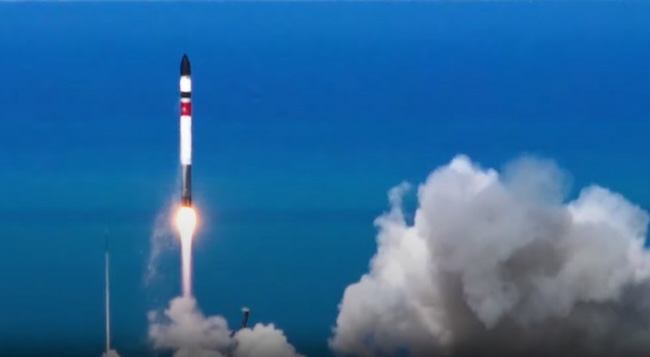
This image captured from Rocket Lab’s YouTube livestream on April 24, 2024, shows its space rocket Electron lifting off from a spaceport in Mahia, New Zealand, carrying South Korea’s first nanosatellite for the country’s satellite constellation project. (Image courtesy of Yonhap)
SEOUL, May 23 (Korea Bizwire) — The science ministry said Thursday its project to develop a low Earth orbit (LEO) satellite communications system has passed a preliminary feasibility study and will officially begin next year.
The 320 billion-won (US$234.3 million) LEO project, also known as South Korea’s Starlink, aims to launch two LEO satellites based on the sixth-generation (6G) communications network technology by 2030, according to the Ministry of Science and ICT.
The ministry also plans to create a demonstration LEO satellite communications system network to support South Korean companies to independently develop core technologies for the system, such as satellite tracking, handover and link, and help them expand their global business.
As the project has passed the government’s preliminary feasibility study, the ministry said it is allowed to allocate its budget from next year and start the project.
An LEO satellite, placed in an orbit 300 to 1,500 kilometers in altitude, can provide high-speed communications with short latency thanks to its close distance to Earth compared with geostationary orbit satellites.
The 3rd Generation Partnership Project (3GPP), a global mobile telecommunication standards organization, is also working to standardize the LEO satellite communications technologies as they have gained the spotlight as a non-terrestrial network, which can cover even remote areas without geographical limit.
Many global tech firms, including the U.S.’ SpaceX and Amazon, have launched LEO satellite services in a bid to secure an early dominance of this highly advanced market.
SpaceX’s Starlink, for instance, uses a swarm of LEO satellites to create a global broadband network.
The science ministry urged Korean companies to prepare to enter the 6G-based LEO satellite communications market considering the market is expected to begin booming in the 2030s after the 6G standardization is completed by 2029.
“We wish to give a fresh boost to the country’s digital and space economy by bolstering our competitiveness in the satellite communications industry,” Ryu Je-myung, head of the network policy department at the science ministry, said.
(Yonhap)






